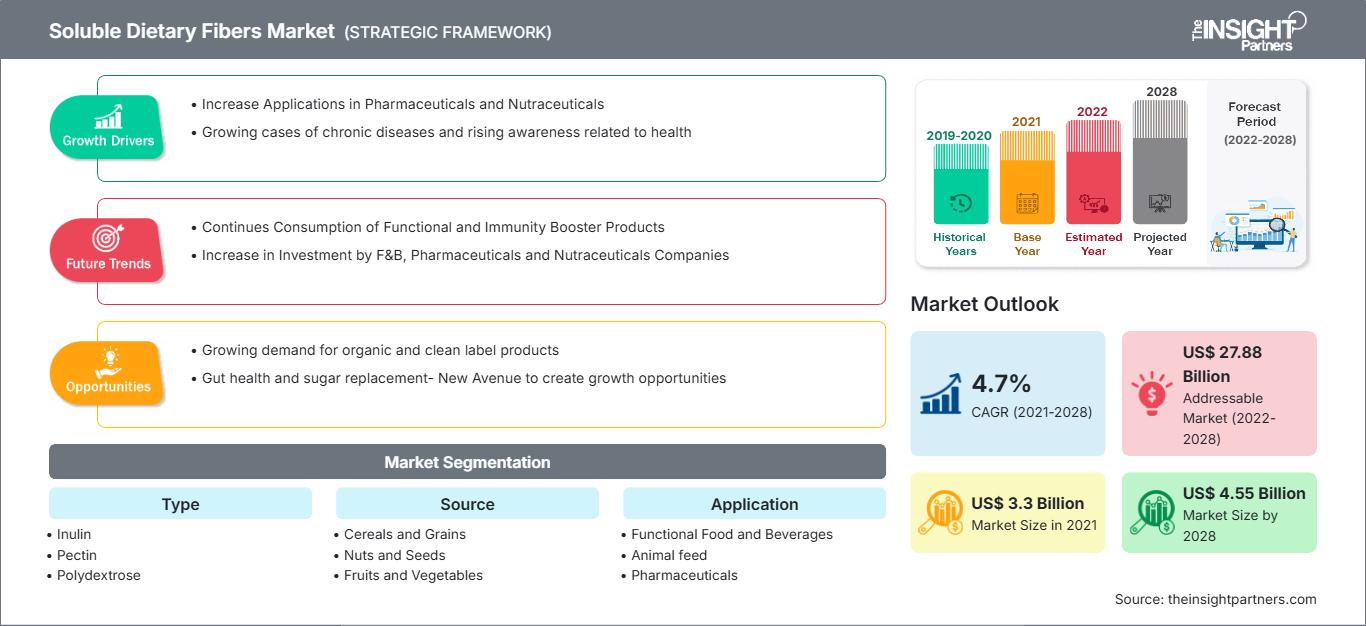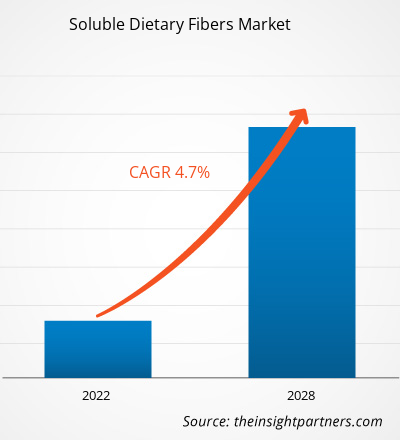Der Markt für lösliche Ballaststoffe soll von 3.301,31 Millionen US-Dollar im Jahr 2021 auf 4.546,47 Millionen US-Dollar im Jahr 2028 wachsen; die durchschnittliche jährliche Wachstumsrate (CAGR) von 2021 bis 2028 liegt bei 4,7 %.
Lösliche Ballaststoffe sind Ballaststoffe, die sich in Wasser auflösen und eine gelartige Masse bilden. Diese Ballaststoffe bilden im Magen-Darm-Trakt viskose Gele und verlangsamen den Transport der Nahrung vom Magen in den Darm. Ballaststoffe dieser Art kommen vor allem in Obst und Gemüse, Hülsenfrüchten und Hafer vor. Lösliche Ballaststoffe fördern die Darmgesundheit, stimulieren Bifidobakterien oder Laktobazillen im Darm, halten die Herzkranzgefäße gesund und senken den Cholesterin- und Blutzuckerspiegel. Der veränderte Lebensstil der Verbraucher und die zunehmende Verwendung von Ballaststoffen als funktionelle Lebensmittelzutat treiben die Nachfrage nach löslichen Ballaststoffen an. Darüber hinaus wird erwartet, dass die wachsende Anwendungsbasis löslicher Ballaststoffe in verschiedenen Branchen wie der Lebensmittel- und Getränkeindustrie, der Pharma- und Nutrazeutikabranche sowie der Tierfutterindustrie in den kommenden Jahren das Marktwachstum ankurbeln wird.
Im Jahr 2021 hatte der asiatisch-pazifische Raum den größten Umsatzanteil am globalen Markt für lösliche Ballaststoffe. Der hohe Verbrauch löslicher Ballaststoffe im asiatisch-pazifischen Raum ist auf das steigende Gesundheits- und Wellnessbewusstsein zurückzuführen. Die Präsenz eines Produktionszentrums und die steigende Nachfrage nach löslichen Ballaststoffen aus der Lebensmittel- und Getränkeindustrie treiben das Marktwachstum in der Region voran. Darüber hinaus wird erwartet, dass der veränderte Lebensstil der Verbraucher, die boomende Lebensmittel- und Getränkeindustrie sowie die Marktdurchdringung globaler Marktteilnehmer das Marktwachstum in den kommenden Jahren vorantreiben werden. Kontinuierliche Forschung und Entwicklung sowie das Wachstum der Pharma- und Nutrazeutikabranche, der Tierfutterindustrie und anderer Branchen haben zu einer weit verbreiteten Akzeptanz löslicher Ballaststoffe auf dem regionalen Markt geführt.
Passen Sie diesen Bericht Ihren Anforderungen an
Sie erhalten kostenlos Anpassungen an jedem Bericht, einschließlich Teilen dieses Berichts oder einer Analyse auf Länderebene, eines Excel-Datenpakets sowie tolle Angebote und Rabatte für Start-ups und Universitäten.
Markt für lösliche Ballaststoffe: Strategische Einblicke

-
Holen Sie sich die wichtigsten Markttrends aus diesem Bericht.Dieses KOSTENLOSE Beispiel umfasst Datenanalysen, die von Markttrends bis hin zu Schätzungen und Prognosen reichen.
Auswirkungen der COVID-19-Pandemie auf den Markt für lösliche Ballaststoffe
Die anhaltende COVID-19-Pandemie hat die Situation im Lebensmittel- und Getränkesektor drastisch verändert und das Wachstum des Marktes für lösliche Ballaststoffe negativ beeinflusst. Die Umsetzung von Maßnahmen zur Eindämmung der Virusausbreitung hat die Situation verschärft und das Wachstum mehrerer Industriezweige beeinträchtigt. Der Markt wurde durch die plötzliche Beeinträchtigung der Betriebseffizienz und Störungen der Wertschöpfungsketten aufgrund der plötzlichen Schließung nationaler und internationaler Grenzen beeinträchtigt. Störungen bei der Rohstoffversorgung von Lieferanten und die vorübergehende Schließung von Produktionsstandorten aufgrund unbefristeter Lockdowns und vorübergehender Quarantänen haben das Marktwachstum während der Pandemie beeinträchtigt. So sehr die Pandemie die Lieferketten beeinträchtigt hat, so sehr hat sie bei den Verbrauchern jedoch auch das Bedürfnis nach einer gesunden Lebensweise geweckt, wodurch die Verbraucher ihre Aufmerksamkeit auf nahrhafte Lebensmittel verlagert haben. So hat beispielsweise laut einem im Juni 2020 von Nutrition Insight veröffentlichten Artikel die Pandemie Wachstumschancen für den Ballaststoffmarkt geschaffen, da Bio-, Natur- und Clean-Label-Produkte stärker gefragt sind und ein starker Fokus auf Darmgesundheit und Zuckerersatz liegt. Gemäß den Gesundheitsrichtlinien der Weltgesundheitsorganisation (WHO) ist die tägliche Aufnahme von 25 g Ballaststoffen zwingend erforderlich, um die Immunität gegen Mikroben aufzubauen. Lösliche Ballaststoffe aus Hafer, Gerste, Erbsen, Äpfeln, Zitrusfrüchten und Kartoffeln sowie chemisch hergestellte sulfatierte Glucane können Verstopfung lindern und zeigen starke antivirale Eigenschaften. Laut der International Scientific Association for Pro- and Prebiotics (ISAPP) gelten Inulin und Oligofructose als wichtige Arten pflanzlicher, präbiotischer löslicher Ballaststoffe, die die Darmgesundheit fördern können, was in Zeiten der Pandemie von entscheidender Bedeutung ist. So greifen Verbraucher laut einem Artikel von FoodIngredientsFirst aktiv auf Bio-Zichorienwurzelfasern zurück. Dieser Ballaststoff besteht aus löslichem Inulin und trägt zur Darmgesundheit, dem psychischen Wohlbefinden und der Immunität bei. Mit dem wachsenden Trend zum Konsum von funktionellen und immunstärkenden Produkten wird daher erwartet, dass die Nachfrage nach löslichen Ballaststoffen in der Zeit nach der Pandemie florieren wird. Da die Volkswirtschaften planen, ihre Aktivitäten wieder anzukurbeln, wird zudem erwartet, dass die Nachfrage nach löslichen Ballaststoffen weltweit steigen wird. Die steigende Nachfrage nach löslichen Ballaststoffen in der Lebensmittel- und Getränkeindustrie Getränke, Pharmazeutika und Nutraceutika, Tierfutter und andere Branchen sowie erhebliche Investitionen namhafter Hersteller werden voraussichtlich den Markt für lösliche Ballaststoffe ankurbeln.
Markteinblicke
Zunehmende Anwendung löslicher Ballaststoffe in Pharmazeutika und Nutraceutika
Lösliche Ballaststoffe werden als Lebensmittelzusatzstoff verwendet und fördern die Darmgesundheit, stimulieren Bifidobakterien oder Lactobacillus im Darm, die Gesundheit der Herzkranzgefäße und senken den Cholesterinspiegel sowie den Glukosestoffwechsel. Darüber hinaus tragen lösliche Ballaststoffe zur Gewichtskontrolle bei und senken das Risiko von Herz-Kreislauf-Erkrankungen. Wasserlösliche Ballaststoffe gelten als eine der wichtigsten Formen von Ballaststoffen. Es besteht aus Inulin, Beta-Glucan, Polydextrose, Pektin, Fructooligosacchariden, Galactooligosacchariden und Maisfasern, die das Nährwertprofil der zugesetzten Lebensmittel und Getränke verbessern.
Roquette bietet beispielsweise unter seiner Marke „NUTRIOSE“ nichtviskose lösliche Ballaststoffe für die Lebensmittel-, Pharma- und Nutraceutikaindustrie an. NUTRIOSE wird aus Getreide wie Weizen und Mais hergestellt und ist gut verdaulich. Ebenso bietet Steadfast Nutrition, ein Premiumunternehmen für Sport- und Wellnessernährung, unter der Marke Tri Fiber Nahrungsergänzungsmittel in Pulverform auf Basis löslicher Ballaststoffe an. Die löslichen Ballaststoffe unterstützen die Darmgesundheit sowie einen ausgeglichenen Blutzuckerspiegel und Serumlipidspiegel. Außerdem reguliert das Produkt die Appetithormone, fördert die Darmtätigkeit und reguliert den Triglyceridspiegel im Körper, um durch Kontrolle des Cholesterinspiegels das Lipidprofil zu verbessern. Die verbesserten Wirkungen von resistentem Maltodextrin werden von Foods for Specified Health Use (FOSHU) anerkannt. Das Produkt kann von Büroangestellten, Weight Watchers, Sportlern und Fitnessbegeisterten sowie Patienten konsumiert werden. Ebenso sind Benefiber und Metamucil rezeptfreie (OTC) lösliche Ballaststoffpräparate. Benefiber ist von der Food and Drug Administration (FDA) als Ballaststoffpräparat zugelassen und enthält als Wirkstoff Weizendextrin. Es hilft, Wasser im Darmtrakt zu absorbieren und stimuliert die Peristaltik oder die wiederholte Kontraktion und Entspannung der Darmmuskulatur. Metamucil wird aus Flohsamenschalen hergestellt, die aus den Samen des indischen Krauts Plantago ovata gewonnen werden. Der wachsende Fokus auf Gesundheit, das zunehmende Bewusstsein für die gesundheitlichen Vorteile löslicher Ballaststoffe und die zunehmende Zahl chronischer Krankheiten haben die Hersteller dazu motiviert, Nutraceutika und Pharmazeutika auf Basis löslicher Ballaststoffe herzustellen, was die Nachfrage nach löslichen Ballaststoffen auf dem Weltmarkt voraussichtlich ankurbeln wird.
Typ-Einblicke
Basierend auf dem Typ ist der Markt für lösliche Ballaststoffe in Inulin, Pektin, Polydextrose, Beta-Glucan und andere segmentiert. Im Jahr 2021 dominiert das Inulin-Segment den Markt. Inulin ist ein löslicher Ballaststoff, der aus vielen Pflanzen gewonnen wird. Zur Gewinnung von Inulin werden verschiedene Obst-, Gemüse- und Kräutersorten verwendet, darunter Weizen, Zwiebeln, Knoblauch, Bananen, Lauch, Artischocken, Zichorienwurzeln und Spargel. Für medizinische Zwecke wird Inulin üblicherweise aus Zichorienwurzeln gewonnen. Inulin wird zur Gewichtsabnahme, bei Verstopfung, Durchfall und Diabetes eingesetzt. Es wird auch zur Verabreichung therapeutischer Medikamente verwendet. Inulinpräparate sind in Kapsel- und Pulverform erhältlich. Inulin wird in einer Vielzahl von Produkten verwendet, darunter Milchprodukte, Brot, Müsliriegel, Gesundheitsnahrung, Neugeborenennahrung, Getränke, Süßwaren, Eiscreme und herzhafte Speisen. Viele Lebensmittelhersteller fügen verarbeiteten Produkten Inulin hinzu, um deren Präbiotikagehalt zu erhöhen, Fett und Zucker in Lebensmitteln zu ersetzen und den gesundheitlichen Nutzen von Lebensmitteln zu verbessern, da es sich positiv auf die Darmgesundheit auswirkt. Inulin verbessert Geschmack und Textur. In hoher Konzentration kann Inulin aufgrund seiner physikochemischen Bedeutung das Texturprofil von Produkten verändern.
Quelleninformationen
Basierend auf der Quelle ist der Markt für lösliche Ballaststoffe in Getreide und Körner, Obst und Gemüse sowie Sonstiges unterteilt. Im Jahr 2021 dominiert das Segment Getreide und Körner den Markt. Verschiedene Getreidearten wie Weizen, Gerste, Hafer, Roggen und Mais werden als Quelle zur Herstellung löslicher Ballaststoffe verwendet. Weizenkleie, die äußere Schicht des Vollkornweizens, ist eine ausgezeichnete Quelle für Präbiotika. Weizenkleie hilft, Verdauungsprobleme wie Blähungen, Krämpfe und Bauchschmerzen zu lindern. Hafer enthält einen hohen Anteil löslicher Ballaststoffe. Hafer wird zur Herstellung von Frühstücksflocken, Brot, Scones, Flapjacks oder Obststreuseln verwendet. Er enthält Beta-Glucan, das hilft, den Blutzuckerspiegel zu kontrollieren. Gerste ist eine weitere Getreidepflanze mit einem sehr hohen Anteil an Ballaststoffen, insbesondere an löslichen Ballaststoffen. Gerste enthält etwa 3,5–5,9 % des löslichen Ballaststoffs Beta-Glucan.
Anwendungseinblicke
Basierend auf der Anwendung ist der Markt für lösliche Ballaststoffe in Lebensmittel und Getränke, Tierernährung, Pharmazeutika und Nutrazeutika und Sonstiges unterteilt. Im Jahr 2021 dominiert das Segment Lebensmittel und Getränke den Markt. Es gibt verschiedene Arten von löslichen Ballaststoffen, die in der Lebensmittel- und Getränkeindustrie verwendet werden. Diese löslichen Ballaststoffe werden als Zutat in vielen Anwendungen verwendet, darunter Milchprodukte, Backwaren, Proteinriegel, Müsliriegel, Getränke, Süßwaren, Eiscreme, Desserts, Erfrischungsgetränke, Brot und Produkte auf Getreidebasis. Lösliche Ballaststoffe wie Inulin, Polydextrose, Pektin und Dextrine werden als Fett- und Zuckerersatz in Lebensmitteln verwendet. Da Inulin farblos ist, kann es in vielen Lebensmitteln verwendet werden, ohne deren Aussehen, Textur oder Geschmack zu beeinträchtigen. Pektin wird als Verdickungsmittel bei der kommerziellen Herstellung von Gelees, Konfitüren und Marmeladen eingesetzt. Lösliche Ballaststoffe verbessern Geschmack und Textur und bieten gleichzeitig viele gesundheitliche Vorteile.
Einige wichtige Akteure auf dem Markt für lösliche Ballaststoffe sind Beneo GmbH, Roquette Frères, Ingredion Incorporated, Tate & Lyle Plc und Cargill, Incorporated. Diese Marktteilnehmer konzentrieren sich stark auf die Entwicklung hochwertiger und innovativer Produktangebote.
Lösliche Ballaststoffe
Regionale Einblicke in den Markt für lösliche Ballaststoffe
Die Analysten von The Insight Partners haben die regionalen Trends und Faktoren, die den Markt für lösliche Ballaststoffe im Prognosezeitraum beeinflussen, ausführlich erläutert. In diesem Abschnitt werden auch die Marktsegmente und die geografische Lage in Nordamerika, Europa, dem asiatisch-pazifischen Raum, dem Nahen Osten und Afrika sowie Süd- und Mittelamerika erörtert.
Umfang des Marktberichts über lösliche Ballaststoffe
| Berichtsattribut | Einzelheiten |
|---|---|
| Marktgröße in 2021 | US$ 3.3 Billion |
| Marktgröße nach 2028 | US$ 4.55 Billion |
| Globale CAGR (2021 - 2028) | 4.7% |
| Historische Daten | 2019-2020 |
| Prognosezeitraum | 2022-2028 |
| Abgedeckte Segmente |
By Typ
|
| Abgedeckte Regionen und Länder |
Nordamerika
|
| Marktführer und wichtige Unternehmensprofile |
|
Die Dichte der Marktteilnehmer für lösliche Ballaststoffe: Verständnis ihrer Auswirkungen auf die Geschäftsdynamik
Der Markt für lösliche Ballaststoffe wächst rasant. Die steigende Nachfrage der Endverbraucher ist auf Faktoren wie veränderte Verbraucherpräferenzen, technologische Fortschritte und ein stärkeres Bewusstsein für die Produktvorteile zurückzuführen. Mit der steigenden Nachfrage erweitern Unternehmen ihr Angebot, entwickeln Innovationen, um den Bedürfnissen der Verbraucher gerecht zu werden, und nutzen neue Trends, was das Marktwachstum weiter ankurbelt.

- Holen Sie sich die Markt für lösliche Ballaststoffe Übersicht der wichtigsten Akteure
Bericht-Spotlights
- Fortschreitende Branchentrends im Markt für lösliche Ballaststoffe, um Akteuren bei der Entwicklung effektiver langfristiger Strategien zu helfen
- Geschäftswachstumsstrategien in entwickelten und sich entwickelnden Märkten
- Quantitative Analyse des Marktes für lösliche Ballaststoffe von 2019 bis 2028
- Schätzung der weltweiten Nachfrage nach löslichen Ballaststoffen
- PEST-Analyse zur Veranschaulichung der Wirksamkeit von Käufern und Lieferanten in der Branche
- Jüngste Entwicklungen zum Verständnis des wettbewerbsorientierten Marktszenarios
- Markttrends und -aussichten sowie Faktoren, die das Wachstum des Marktes für lösliche Ballaststoffe vorantreiben und hemmen
- Unterstützung im Entscheidungsprozess durch Hervorhebung von Marktstrategien, die das kommerzielle Interesse untermauern und zum Marktwachstum führen
- Detaillierter Überblick und Segmentierung des Marktes sowie der Branchendynamik für lösliche Ballaststoffe
- Größe des Marktes für lösliche Ballaststoffe in verschiedenen Regionen mit vielversprechendem Wachstum Chancen
Markt für lösliche Ballaststoffe nach Typ
- Inulin
- Pektin
- Polydextrose
- Beta-Glucan
- Sonstige
Markt für lösliche Ballaststoffe nach Quelle
- Getreide und Körner
- Obst und Gemüse
- Sonstige
Markt für lösliche Ballaststoffe nach Anwendung
- Lebensmittel und Getränke
- Tierernährung
- Pharmazeutika und Nutraceutika
- Sonstige
Firmenprofile
- Cargill, Incorporated
- Kerry Group
- Ingredion Incorporated
- Nexira
- Roquette Frères
- ADM
- Tate And Lyle PLC
- IFF Nutrition & Biowissenschaften
- Beneo GMBH
- Cosucra
- Historische Analyse (2 Jahre), Basisjahr, Prognose (7 Jahre) mit CAGR
- PEST- und SWOT-Analyse
- Marktgröße Wert/Volumen – Global, Regional, Land
- Branchen- und Wettbewerbslandschaft
- Excel-Datensatz
Aktuelle Berichte
Erfahrungsberichte
Grund zum Kauf
- Fundierte Entscheidungsfindung
- Marktdynamik verstehen
- Wettbewerbsanalyse
- Kundeneinblicke
- Marktprognosen
- Risikominimierung
- Strategische Planung
- Investitionsbegründung
- Identifizierung neuer Märkte
- Verbesserung von Marketingstrategien
- Steigerung der Betriebseffizienz
- Anpassung an regulatorische Trends






















 Kostenlose Probe anfordern für - Markt für lösliche Ballaststoffe
Kostenlose Probe anfordern für - Markt für lösliche Ballaststoffe